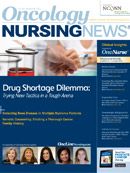Drug Shortages Frustrate Nurses and Jeopardize Patient Care
The promise of a solution somewhere on the horizon for America's drug shortages isn't enough for the registered nurse who navigates shortages every day.
Linda Weisenberger, RN, OCN
Linda Weisenberger knows that leaders in the public and private sectors are working to resolve America’s drug shortages.
But the promise of a solution somewhere on the horizon isn’t enough for the registered nurse, who navigates supply shortages every day as clinical coordinator of the cancer program at Genesee Cancer and Blood Treatment Center in Flint, Michigan. In the 22-chair private chemotherapy infusion clinic, Weisenberger, RN, OCN, and her colleagues frequently must carry out treatment plans without the medications best suited to patients’ curative or palliative care.
“We’ve had to change the protocols recommended in NCCN [National Comprehensive Cancer Network] guidelines and by our doctors because we were unable to get a drug, which results in us giving our patients archaic treatment,” she said.
Due to drug unavailability, Weisenberger has given medications to be taken at home that should have been administered intravenously, increasing the risk of dosing mistakes. She has given a cancer drug to the lucky patients who showed up when it was available, then had none for those who came the next day.
Weisenberger has watched patients endure nausea, vomiting, and diarrhea when drugs added to their chemotherapy infusions could have spared them those symptoms. She’s seen substitutes for standard-of-care drugs discontinued in favor of even less effective medications due to side effects, and she’s seen patients dropped or excluded from clinical trials because protocol drugs were unavailable.
And she’s not alone. Joni Lutman, MSN, FNP-C, a nurse practitioner at James Cancer Hospital at Ohio State Medical Center, has also seen patients suffer because of drug shortages.
Lutman, who treats head and neck cancers, said shortages of liquid antibiotics and pain medications have been difficult for her patients, who, after treatment with chemotherapy, often can’t swallow. As alternatives, she said, patients sometimes must take solid drugs that have been crushed.
If you ask Weisenberger, the situation isn’t improving much.
“Every day,” she said, “I hear of a drug I have to stock up on right now, because in a couple of months we won’t be able to get it.”
While certain oncology drugs were previously hard to find, it’s now ancillary drugs, like furosemide (Lasix), atropine, potassium, and mannitol, that are in short supply, leaving some patients in danger of side effects including kidney problems, Weisenberger noted.
To work around the shortages, Weisenberger has been involved in borrowing between hospitals and clinics. She’s also spent lots of early mornings calling distributors of desired drugs.
“The manufacturer might send them five cases, and if I wanted them, I’d have to be one of the first people to ask for it,” she said.
And that’s just one of many inconveniences associated with drug shortages, the nurses agreed.
While drugs in shortage are often inexpensive generics, Weisenberger pointed out, brand-name alternatives can cost much more—and sometimes insurers refuse to pay.
“Normally they’ll pay it after an appeal,” she said, “but it’s the physician who initially pays for that drug, and that means he might not get paid back for a year-and-a-half.”
Lutman added that many insurers refuse to approve drugs without preauthorization, and in some cases require patients to try a different medication before the one their doctor has prescribed.
“They want to try the least costly alternative first,” she said, “but with antiemetics, for example, we prefer to give a drug specific to fighting cancer side effects, like Zofran (odansetron). Cheaper alternatives might make the patient sleepy, and if he’s already on pain medication, we don’t want to make him more tired.”
Overall, Lutman said, the process of finding alternatives for drugs in short supply is “time consuming. It takes away from other things, like seeing the patient.”

Innovative Program Reduces Nurse Turnover and Fosters Development
Published: September 12th 2024 | Updated: September 12th 2024The US Oncology Network (The Network) has developed one of the most comprehensive programs in the nation to support the professional development and retention of new oncology nurses.



